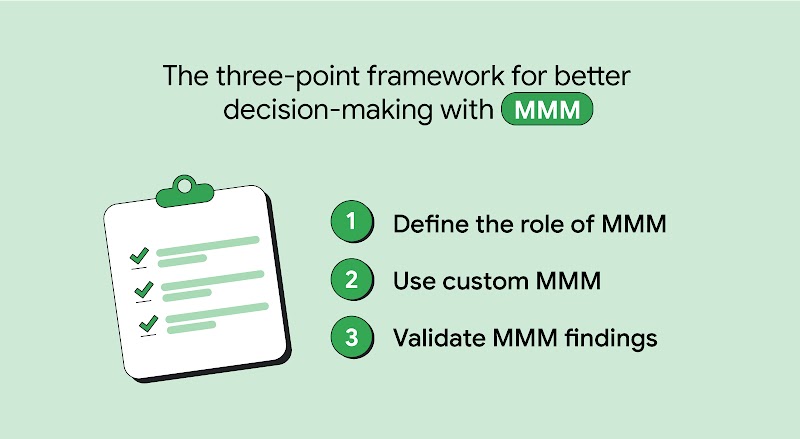
It’s happening. More businesses are using marketing mix modelling (MMM) to evaluate their ad spend and decide how they optimise for revenue growth.
And first-movers have hit upon a three-point framework that helps them better use MMM to make fully informed investment decisions that drive business goals.

Businesses are embracing MMM because it’s a privacy-centric statistical method that provides a holistic view of how one’s marketing spend and activities drive sales. It uses only aggregated data, so businesses have a sustainable data source for measurement that’s unaffected by privacy regulations.
And because MMM is able to analyse a wide range of data and measurements across complex marketing activities, it’s useful to all types of advertisers, including brand advertisers who want to drive performance, and performance advertisers who want to raise brand awareness.
Businesses ahead of the curve have also realised that how their MMM is set up, and the way the results are used to guide decision-making, affect how well they make decisions.
The framework for better decision-making with MMM
A robust decision-making framework, powered by MMM insights, comprises three points: defining the role of MMM, using a custom model, and validating the MMM findings. By applying this framework to your use of MMM, you can better make decisions about the optimal way to invest your marketing spend and get the highest returns.

1. Define the role of MMM
MMM has clear strengths like its ability to provide a holistic view of how various factors contribute to business goals, including advertising, product updates, price promotions, seasonality, and competitor impact. But it also has limitations.
For instance, MMM cannot provide granular insights into campaign improvements because it uses aggregated data instead of user-level data; marketing experiments and campaign attributions might be better suited for that purpose.
To ensure you’re using MMM well for decision-making, start by defining its purpose, including the questions you want it to answer. MMM is highly suited for helping businesses make marketing investment decisions and regular budget reallocations across marketing activities.
2. Use custom MMM
The model you use should precisely match your unique business structure, goals, and marketing activities. It should reflect how your business operates, from the myriad sales channels you use to your advertising structure and the synergy between your media investments.
The model should also take into account anything that affects your revenue, and analyse data from those sources. That includes your sales data, marketing activities, public information on the marketing activities of your peers, and seasonal and macroeconomic factors.
This playbook gives guidance on how to find a model that meets your specific business needs. You can also get a model built for your needs by collaborating with partners. Industry experts and media specialists have deep knowledge and a holistic view of things, and they can help you develop a comprehensive, custom MMM.
3. Validate MMM findings
As a quantitative solution, MMM can identify which marketing activities and media channels contribute to your goals, and suggest data-driven budget adjustments to maximise your returns.
But it’s unable to qualify why the marketing activities and channels it identified were, or were not, effective. Nor can it provide justifications for its budget recommendations.
To better understand the results and recommendations provided by the model and make a fully informed business decision, validate your MMM findings. Supplement them with measurement solutions and findings across the marketing funnel, such as unique audience reach, brand lift, and incremental conversions.

LG Electronics tapped into MMM because it wanted to better make decisions about its marketing performance and investments.
However, the model it used initially did not reflect its complex business operations. So it worked with Accenture, which partnered with Google, to develop a custom model.
The bespoke model took into account the various factors that affect its revenue. That included the different purchase paths of its customers and the myriad touchpoints that contributed to sales, such as organic search and social media.
The result showed that its digital video ads drove a return on ad spend of between 1.7X and 3.6X, as compared with media such as TV, and YouTube was a key driver of incremental revenue.

That performance data was helpful for LG Electronics in evaluating its ad spend. But it wanted to know why digital video ads were significantly more effective for its business, before making a fully informed decision about how its marketing budgets should be reallocated.
So it turned to Total Ad Ratings studies for insights and learnt that digital video ads were better at reaching its intended audience. Having validated the findings from its custom MMM, it was ready to make confident decisions about its marketing investments.

For global beverage brand Nespresso, a thirst to evaluate the effectiveness of its myriad marketing activities in South Korea — across campaign types, media channels, and sales avenues, led it to use MMM. And it worked with Monks, which partnered with Google, to develop a custom model.
The multi-layered model took into account various factors that affect its revenue in South Korea. These included the different purchase paths on its website and app, and its brand and performance campaigns. As a result, Nespresso gained valuable insights into its business drivers.
For instance, it discovered that its YouTube brand campaigns delivered a 2X return on ad spend when compared with social media, and a 1.1X return on ad spend when compared with TV.
That finding affirmed its decision to use YouTube brand campaigns in the first place, even though it is a well-established brand. For Nespresso, YouTube brand campaigns play a significant role in helping it engage and acquire customers.

But it was curious to understand why its campaigns on YouTube were more effective than on social media. So it conducted additional research using Insights Finder and found that YouTube is the platform that successfully reaches and engages its key audience segment in South Korea.
Having validated its MMM results, it gained confidence to experiment with its marketing budget allocations and optimise them to drive maximum returns.
Indeed, when used well, MMM can be a powerful tool that helps you better make decisions about your marketing investments. And as advanced users of MMM have learnt, defining the purpose of the MMM, using a custom model, and validating the results will let you make fully informed business decisions about how you optimise your ad spend to drive revenue more efficiently and effectively.



